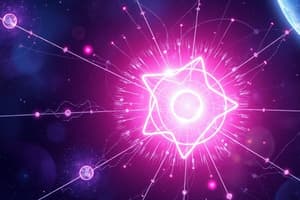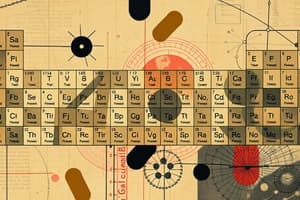Podcast
Questions and Answers
What is the frequency of red light produced by strontium salts with a wavelength of $6.50 \times 10^{-7}$ m?
What is the frequency of red light produced by strontium salts with a wavelength of $6.50 \times 10^{-7}$ m?
- $4.62 \times 10^{14}$ Hz (correct)
- $4.62 \times 10^{13}$ Hz
- $3.00 \times 10^{14}$ Hz
- $2.31 \times 10^{14}$ Hz
Which of the following elements has the electron configuration $1s^2 2s^2 2p^6 3s^2 3p^3$?
Which of the following elements has the electron configuration $1s^2 2s^2 2p^6 3s^2 3p^3$?
- Arsenic
- Potassium
- Silicon
- Phosphorus (correct)
What is the abbreviated electron configuration for Silver?
What is the abbreviated electron configuration for Silver?
- [Xe] 5d^9 6s^2
- [Xe] 4f^{14} 5d^{10} 6s^1
- [Kr] 4d^{10} 5s^1 (correct)
- [Kr] 4d^9 5s^2
How is the energy of a gamma-ray photon calculated using its frequency of $5.02 \times 10^{21}$ Hz?
How is the energy of a gamma-ray photon calculated using its frequency of $5.02 \times 10^{21}$ Hz?
Which principle states that no two electrons in the same atom can have the same set of four quantum numbers?
Which principle states that no two electrons in the same atom can have the same set of four quantum numbers?
Flashcards
Aufbau's Principle
Aufbau's Principle
The Aufbau Principle states that electrons fill orbitals starting with the lowest energy level first, and move up to higher energy levels only after all lower levels are full.
Pauli Exclusion Principle
Pauli Exclusion Principle
The Pauli Exclusion Principle states that no two electrons in an atom can have the same set of four quantum numbers. In other words, an atomic orbital can hold a maximum of two electrons, and these must have opposite spins.
Hund's Rule
Hund's Rule
Hund's Rule states that electrons fill orbitals individually before pairing up in the same orbital. Also, all electrons in singly occupied orbitals have the same spin.
Wavelength and Frequency
Wavelength and Frequency
Signup and view all the flashcards
Photon Energy
Photon Energy
Signup and view all the flashcards




